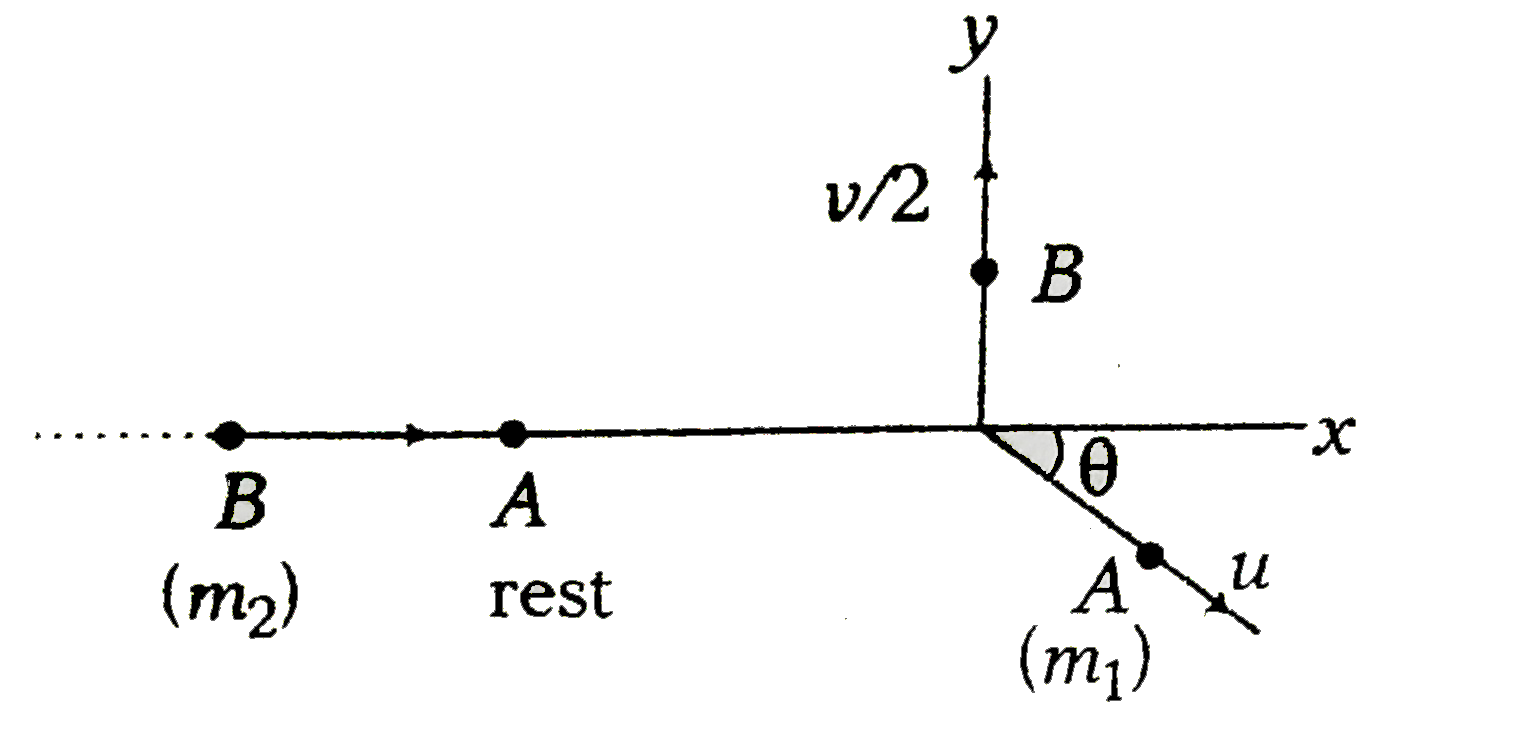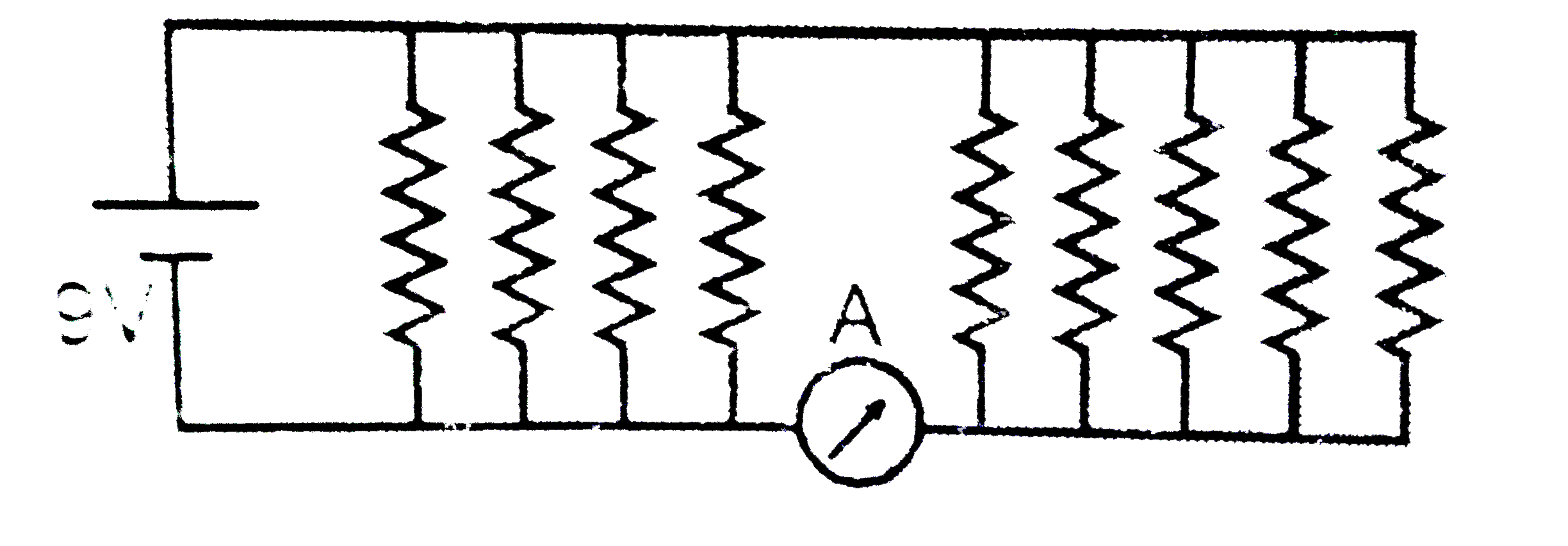Two sphere AandB of masses m1andm2 respectivelly colides. A is at rest initally and B is moving with velocity v along x-axis. After collision B has a velocity v2 in a direction perpendicular to the original direction. The mass A moves after collision in the direction.
same as that of B
opposite to that of B
θ=tan−(12) to the X-axis
θ=tan−(−12) to the X-axis
The correct Answer is:C
Here ,pi=m2vˆi+m1×0

pf=m2v/2ˆj+m91)×v1
v1=(m2m1)ˆi−(m2m1)v2ˆj from this equatin, we can find
tanθ=12
θ=tan−1(12) to the X-axis.
Topper's Solved these Questions
- CENTRE OF MASSBOOK - DC PANDEYCHAPTER - CENTRE OF MASSEXERCISE - Match the coloumns
9 Videos
- CALORIMETRY AND HEAT TRANSFERBOOK - DC PANDEYCHAPTER - CALORIMETRY AND HEAT TRANSFEREXERCISE - Medical entrance s gallery
38 Videos
- CENTRE OF MASS, IMPULSE AND MOMENTUMBOOK - DC PANDEYCHAPTER - CENTRE OF MASS, IMPULSE AND MOMENTUMEXERCISE - Comprehension type questions
15 Videos
Similar Questions
If net force on a system of particles is zero. Then
Column IColumn II(A)Acceleration of centre of mass(p)Constant(B)Velocity of centre of mass(q)Zero(C)Momentum of centre of mass(r)May be zero(D)Velocity of an individual particle of the system(s)May be constant
View SolutionA black body is at a temperature of 5760K. The energy of radiation emitted by the body at wavelength 250nm is U1 at wavelength 500nm is U2 and that at 1000nm is U3. Wien's consant, b=2.88×106nmK. Which of the following is correct?
View SolutionComprehension # 1
If net force on a system in a particular direction is zero (say in horizontal direction), we can apply: ΣmRxR=ΣmLxL,ΣmRvR=ΣmLvL and ΣmRaR=ΣmLaL
Here R stands for the masses which are moving towards right and L for the masses towards left, x is displacement, v is velocity and a the acceleration (all with respect to ground).
A small block of mass m=1kg is placed over a wedge of mass M=4kg as shown in figure. Mass m is released from rest. All surface are smooth. Origin O is as shown.

Final velocity of the wedge is ..........m/s :-
View SolutionTwo sphere A and B of masses m_(1) and m_(2) respectivelly colides. A is at rest initally and B is moving with velocity v along x-axis. After collision B has a velocity (v)/(2) in a direction perpendicular to the original direction. The mass A moves after collision in the direction.
View SolutionA ball of mass m moving with velocity V, makes a head on elastic collision with a ball of the same moving with velocity 2V towards it. Taking direction of V as positive velocities of the two balls after collision are.
View SolutionTwo different unknown masses A and B collide. A is initially at rest when B has a speed v. After collision B has a speed v/2 and moves at right angles to its original direction of motion. Find the direction in which A moves after collision.
View SolutionA mass ‘m’ moves with a velocity ‘v’ and collides inelastically with another identical mass at rest. After collision the 1st mass moves with velocity (v)/(sqrt(3)) in a direction perpendicular to the initial direction of motion. Find the speed of the 2^(nd) mass after collision :
View Solutionm1 और m2 द्रव्यमान के दो गोले आपस में टकराते हैं । प्रारंभ में A स्थिर तथा B वेग V से X - अक्ष के अनुदिश गतिशील हैं । टक्कर के पश्चात B का वेग V2 उसके प्रारंभिक वेग की लंबवत दिशा में हो जाता है । टक्कर के पश्चात द्रव्यमान A की गति की दिशा होगी -
View SolutionTwo different unknown masses A and B collide. A is initially at rest when B has a speed v. After collision B has a speed v/2 and moves at right angles to its original direction of motion. Find the direction in which A moves after collision.
View SolutionTwo different unknown masses A and B collide. A is initially at rest when B has a speed v. After collision B has a speed v/2 and moves at right angles to its original direction of motion. Find the direction in which A moves after collision.
View Solutionक्रमश: m1 तथा m2 द्रव्यमान के दो गोले A तथा B आपस में टकराते है । प्रारम्भ में A स्थिर तथा B वेग v से X-अक्ष के अनुदिश गतिमान है। टक्कर के पश्चात B का वेग v2 उसके प्रारम्भिक वेग की लंबवत दिशा में हो जाता है। टक्कर के पश्चात द्रव्यमान A की गति की दिशा होगी
View SolutionRespectively m_1 And m_2 Two spheres of mass A and B collide, initially A is at rest and B is moving along the velocity v from the x-axis. After the collision, the velocity of B becomes v / 2 in the perpendicular direction of its initial velocity. So, after the collision the direction of motion of the sphere A will be:
View SolutionA body of mass m1 moving with a velocity 3m/s collides with another body at rest of m2 . After collision the velocities of the two bodies are 2m/s and 5m/s , respectively , along the direction of motion of m1. The ratio m1/m2 is
View SolutionA mass m moves with a velocity v and collides inelastically with another identical mass at rest. After collision, the first mass moves with velocity v/(sqrt3) in a direction perpendicular to Before collision the initial direction of motion. The speed of the 2^(nd) mass after collision
View SolutionTwo spheres A and B of masses m1andm2 respectively collide. A is at rest initially and B is moving with velocity v along x-axis. After collision B has a velocity v2direction perpendicular to the original direction. The mass A moves after collision in the direction
View SolutionTwo spheres a and B of masses m1 and m2 respectively collide. A is at rest initially and B is moving with velocity v along x-axis. After collision B has a velocity v/2 in a direction perpendicular to the original direction. The mass A moves after collision in the direction
View Solution

